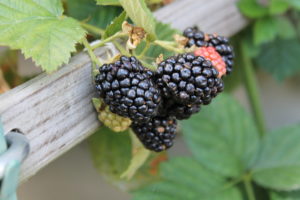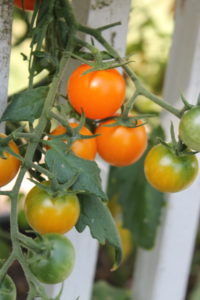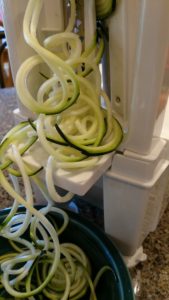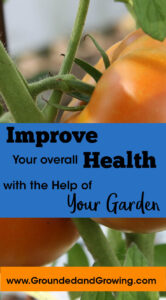The Food Pharmacy, an innovative program from Geisinger Health System in Shamokin, Pennsylvania has shown incredible success in removing patients’ barriers to healthy eating AND created measurable improvements in their health. Can we look at our own gardens with new eyes and bring the “Food Pharmacy” approach to our own households?
Disclaimers: This post contains affiliate links. Also, cookies and chocolate were consumed while writing this post about eating more fruits and vegetables.
My maternal grandma had her first heart attack when she was 44 years old and pregnant. My mom had her first heart attack when she was 49 years old. Those two statistics have been rattling around my brain ever since I turned 40. Can I break the family cycle of having heart attacks in my 40’s?
I know that what I eat has an effect on my health. I’ve experienced it in good ways and bad. In what seems like a lifetime ago and yesterday at the same time– before I had kids or a husband– just me, myself and I– healthy eating seemed a lot easier. My needs were all I had to worry about. My cholesterol levels were a perpetual problem, but I finally brought the numbers down to the normal range with a combination of healthy eating and regular exercise.
But of course life creeps in and can undermine our best intentions. My numbers are no longer where they should be– my cholesterol and blood sugars are creeping up. No surprise, considering the stress I’ve put my body through with 4 pregnancies, 2 children, job stress, no time to exercise regularly, and lots of convenience foods as I maneuvered through life perpetually in “survival mode”. I struggle with choosing fruits and vegetables over sweets and other junk food, particularly if I’m feeling anxious. Which has been quite a bit in recent years.
What if doctors prescribed healthy foods just like they prescribe medicine? Is healthy food the REAL medicine?
The idea of food choices affecting medical conditions is nothing new. Of course, the specific advice changes all the time, but few would argue that the central key of a healthy diet revolves around plenty of fruits and vegetables. But how many of us actually consume the recommended 5 servings of fruits and vegetables each day? A 2015 report from the CDC says only about 10% of Americans eat the recommended servings (13% eat the recommended 2 fruit servings and 9% eat the recommended 3 vegetable servings each day).
If you have any health issues, your doctor or other health care provider has probably mentioned the need to make more nutritious food choices, and you may have rolled your eyes (at least in your mind) and thought to yourself “Well no kidding– But how will I fit this in on top of everything else already on my to-do list?”

Blackberries have been ripening for a couple of weeks now. Whatever escapes my kids’ mouths and makes it into the house goes into the freezer for winter cobblers.
I know what I need to do. But I’m bogged down with the same feeling I get when I sit tired, hot and sweaty looking out at my vegetable garden late in the summer– I’m wonder if it’s worth all the trouble.
Is healthy eating worth all the trouble? How long until I see a difference? Will I see a difference? I need some incentive to stick with it.
I found some real encouragement when I read about Geisinger Health System’s Fresh Food Farmacy Program in Shamokin, Pennsylvania. This part of Pennsylvania has incredibly high levels of poverty and food deserts. Patients can’t easily access healthy foods even if they had the money to do so.
The Fresh Food Farmacy Program dispenses healthy foods to these patients free of charge thanks to generous support from a local foundation and grocery chain. It also offers hands-on cooking instruction and recipes. The program appeared to remove many of the patients’ barriers to healthy eating and started producing positive results in a matter of months.
What did they find?
The Food Pharmacy program specifically targeted patients with Type 2 diabetes. Within the span of the first year of the program, health care providers reported their patients’ health had improved drastically– as measured by weight loss, lower blood pressures and blood sugars and lowered hemoglobin A1C levels. The results amazed even the doctors in charge of the program.
They estimate that the Food Pharmacy spends about $1,000 per year per patient. An elevated hemoglobin A1C level is an indicator of Type 2 diabetes, which brings with it a host of debilitating health problems, some life threatening. For every point a patient can reduce their A1C level, data from the Food Pharmacy program suggests that saves $8,000 in health care costs for that patient. In the first months of the program some patients lowered their hemoglobin A1C levels by up to 3 points, for a projected savings of $24,000. All from a $1,000 investment. That’s a pretty good rate of return! The Fresh Food Farmacy Program continues to evolve and produce amazing success stories.

Our favorite cherry tomatoes– ‘Sunsugar’. Very few of them make it into the house since we all eat them right off the vine in the garden.
This made me look at my garden with new eyes. It’s not just a cute trendy hipster hobby to grow food. Though home vegetable gardening has increased drastically during the pandemic, there are definitely reasons to stick with it well beyond and make gardening part of your life going forward.
Growing food may make you more likely to increase your consumption of fruits and vegetables. A study published in 2008 of urban community gardeners found that gardeners were 3.5 times more likely to consume 5 servings of fruits and vegetables each day than non-gardeners. This statistic alone may be the only reason you need to keep your garden growing.
The benefits of growing food at home don’t stop there– gardening gives us plenty of opportunities for physical exercise and it has been shown to improve our stress levels. Also remember exposure to soil microorganisms may have a direct positive effect on our moods, much like an antidepressant. Seems like a win-win to me!
The idea of prescriptions for healthy eating renews my enthusiasm for eating more fruits and vegetables…. somewhat. I’m privileged enough to not have to worry about accessing healthy foods. I don’t live in poverty. But I still need to strategize and plan if I want to eat healthy. It doesn’t just happen by itself.
So what am I doing to bring the “Food Farmacy” approach to my backyard?
- Carving out time for my health. This means making more time for my garden, both working in it and just learning to relax in it. Yay! The hard part is this may involve saying ‘no’ to some things so you can say ‘yes’ to making healthier choices. My case is an extreme example, but I made a career change partially because no matter how I sliced it, there was no time for my health. I was maxed out, stuffing 10 gallons of activity into a 5 gallon bucket. I was starting to feel the physical effects of no exercise and crappy eating. My chronic stress negatively affected how I related to my family. One of my biggest red flags was when my doctor ordered extra monitoring while I was pregnant with my daughter because of his concern about my stress level.
-

I plant sweet bell peppers in any color I can find. I’ll be making lots of dishes with peppers in the coming weeks and sharing my favorite way to preserve them in an upcoming post. Can you spot the praying mantis on the pepper?
Include your garden or farmer’s market in your meal planning. This may be a big “duh” to many of you reading, but I wasn’t consistently factoring either of these resources in my weekly plans. Meal planning was my number one resolution back in 2017 and it has been a game changer. We are eating a lot more fresh produce in general, and relying a lot less on last minute convenience foods or takeout. I know I’m also spending less on groceries and we’re wasting a whole lot less food than we were a year ago.
- Make eating fruits and vegetables easy. My friend Leia at Moderation Maven reminds me about this regularly with her regular reminders about the virtues of prepping fruits and veggies ahead of time. I used to do this years ago with salads– I would spend time on the weekend making salads for the week and stack them up in the fridge so I could grab and go. It’s work on the front end, but it’s one less thing to do when trying to get out the door in the morning, and one less thing to worry about in the evening as you’re winding down.
- Be strategic about what you grow at home. There are some things I grow no matter what– like tomatoes. When my daughter was a newborn, all I cared about was planting peppers and tomatoes. And I further prioritized by saying as long as I planted some in containers I’d be happy. If I got any planted in the actual vegetable garden that was a bonus. One thing I don’t grow anymore is winter squash. It takes up too much space in my garden. I have local sources where I can easily get my hands on enough squash for my family.
- Eat fruits and veggies in new ways. A couple of years ago I bought a spiralizer to cut vegetables like zucchini

Sautéing zucchini noodles for a couple of minutes in olive oil gives them the perfect al dente pasta texture
and sweet potatoes into pasta-like noodles. It was fun; but then I found out I was pregnant and as the associated exhaustion set in, my spiralizer went back on the shelf. It was over a year before I pulled my copy of “Insprialized“ off the shelf and put my young son to work making zucchini noodles and pesto for dinner. Would you believe my son, my child that is suspicious of any and all vegetables, ate his pesto and zucchini noodles? I know it has to do with 1) he helped pick the produce from our garden and 2) he could proudly proclaim that he “made dinner” that night. My husband knew what I had made, but kept insisting that I must have mixed in regular pasta with the zucchini — I hadn’t. Next, I’m going to dust off my dehydrator, another kitchen appliance that got shelved when life got chaotic.
I’ve been rehashing my life before Grounded and Growing, trying to figure why I didn’t do a better job of taking care of myself. The fact is that I let myself fall off the radar. I put everything and everyone ahead of me. And in the end, I burned out. Could I have “done it all?” No matter how I look at it, the answer is no.
Will I be able to dodge the “family bullet” of having a heart attack in my 40’s? I sure hope so. I know changing my eating habits is just one piece of the puzzle. Looking back at the last few years I know changing my career path has reduced my stress level substantially — another piece of the puzzle. I actually have time now to relax and enjoy my garden — something I talked about but rarely did before. I’m really starting to experience my garden as a means to a healthier existence, both mentally and physically.
If you liked this post, please subscribe to Grounded and Growing today and receive your copy of “15 Tips to Become a '15 Minute Gardener'” so you can spend less time working ON your garden and more time enjoying being IN your garden.! It’s absolutely free. When you join the Grounded and Growing community, you’ll finally take the garden off your “To-Do” list and allow yourself time to enjoy your garden and savor the peace and serenity there. I tell subscribers about new posts as soon as I hit ‘publish’ and send weekly-ish updates on what’s going on in my garden– good, bad AND ugly.

All Rights Reserved. © 2017 Jennifer Schultz Nelson
Great article Jennifer. I love how you have personalized it and let us know you are not just another blogger but actually experience the difficulties of choice and being able to follow through with that choice. I don’t own an automobile so what I buy on my bi-weekly visit at the store usually does not have the freshness at the end of that two weeks and I’m left with what’s on the shelf. I do freeze some fruits and vegetables but there again no space in the apartment freezer. So I eat right for two weeks and the other two is difficult.
Thanks Sharon! I can see where going two weeks between shopping trips would really affect what fresh produce you have in between. Do you have a balcony with your apartment? If you do and it has adequate sun (at least 4 hours for lettuce) you could grow a pot or two of something there.
I have a patio but I am 15 feet from 5 acres of woods and constant shade and moisture. My flowers are all shade flowers so I doubt that vegetable would grow back here. I am sending you a picture of my gardens in another email.
That is a tough situation for vegetables. You may be able to grow some lettuce or other greens if you can keep woodland creatures from them. I’ve seen people grow salad greens in hanging baskets placed higher than deer can reach.
Super post! I actually made zucchini noodles last night to add to a stir fry. They were really good. I’ll have to try some more ideas.
It’s crazy how the texture of the zucchini noodles is so close to regular pasta. We tried broccoli noodles last night where you spiralize the stalks. Delicious! There is a recipe in the cookbook I shared for spiralized “buns” where you use egg to bind the noodles together and cook them like a burger into a bun shape. I’m intrigued and will try it soon. I mentioned in another comment there is also a method of making veggie rice where you pulse the veggie noodles in a food processor until they resemble rice.
Wonderful article Jen. So glad you are sharing your experiences. Hope you and your family continue to do well on your new path!
Thanks Jan. It’s a little nerve-wracking to share my process of changing my direction, but I hope someone out there will see themselves and find some encouragement. It was the right change for me at the right time. It’s like I’m a new person compared to a year ago.
Love this post, Jen! Lots of great ideas, and such an important topic. I never heard of a spiralizer, but I’m now thinking I need one in my life. 🙂
Thanks Kiley! The spiralizer is a lot of fun– my next experiment with it is making veggie rice. You make the noodles and pulse them in a food processor until they look like rice.